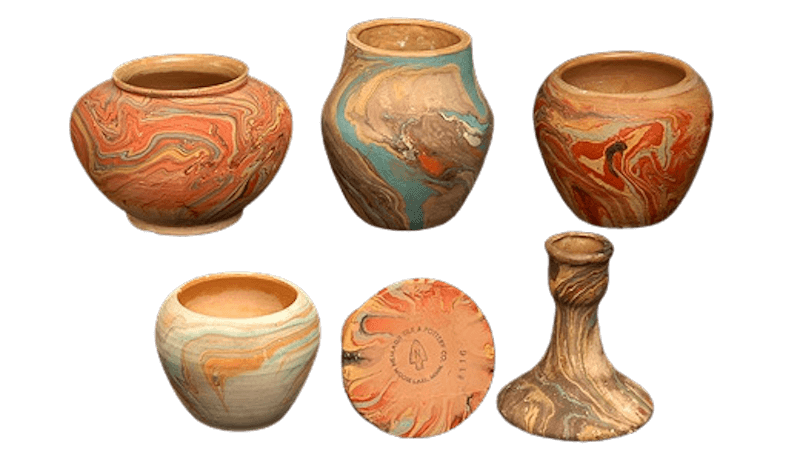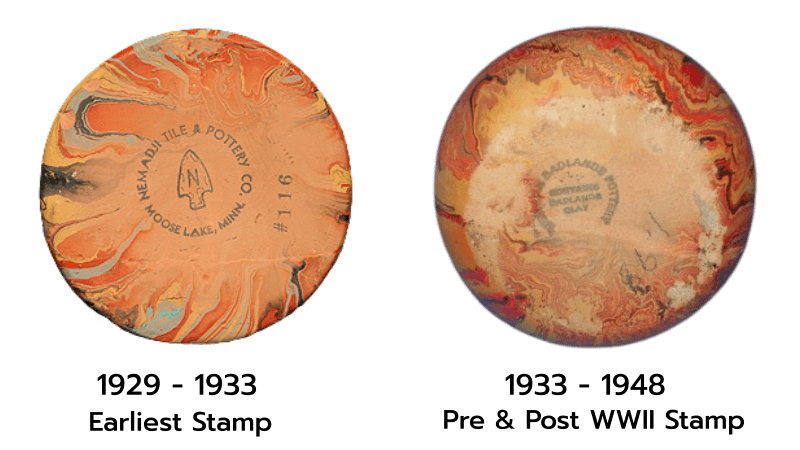If you love buying pottery, you’re likely already familiar with the Nemadji brand, which usually includes random swirls that are a natural earth-tone color. These beautiful pieces have been around for over 100 years and are unglazed and almost crude in design, but they are both gorgeous and unique. While many believe the pieces have a Native American design and origin, they actually got their start in Minnesota.
What is Nemadji Pottery?
Nemadji pottery got its start in 1923 in Moose Lake, Minnesota. It started as a ceramic tile company, but when the crash of 1929 happened, it was sold to someone who wanted to bring attention to the Nemadji name.
And in case you’re wondering, the word Nemadji means “lefthanded” and comes from the Ojibway Indian language. Around the time the new owners came on board, a line of pottery was introduced that took a Native American look, partly because they wanted to appeal to tourists.


Even though these pieces don’t literally come from the Native American people, they were created to look like they did, which is why they all have that very distinct look.
Originally, the pottery pieces even came with a piece of paper that explained why they were named that. It is thought that if the Ojibway tribe had created any type of pottery, they likely would’ve used the clay found in the Nemadji River, which is yet another reason for their name.
Nemadji Pottery History
In 1980, the company that made Nemadji pottery was sold again, and this is also when they stopped making their ceramic tiles. Finally, in 2002 the company closed its doors, but a lot of this pottery is still around and worth some money.
Fortunately, it is still relatively inexpensive to buy and also easy to find, even though the pieces have become extremely popular with collectors. The designs are unique and interesting, and very often, there is a different design on each side of the piece.
So, while this type of pottery didn’t really come from Native Americans, it does indeed have a beautiful Native American “look” and feel, and even today, it still catches tourists’ eyes! Nemadji pottery can now be found in various places in the U.S., especially in the Southwest.
Their swirls of neutral and natural-looking tones are usually the first thing people notice about the pieces. They also have a marbled look and were originally painted with standard house paint, an idea that originated with one of the company’s employees.
How is Nemadji Pottery Made?
Most often, Nemadji pieces are made out of either colored or white clay from the region in Minnesota where they originated. Each piece is hand-thrown and fired in a kiln, even though it is left unfinished on the outside, which is one of the reasons it is so unique.
The firing in the kiln hardened the piece, but it was left in the bisque or unglazed state to give it the look it became known for, which is quite attractive and eye-catching.
Once the manufacturer completed the firing process, they floated the pottery on a vat of water that contained house paints separated by vinegar. Afterward, they dipped the piece in the paints and let the paint dry for a long time so it would stick to the surface.
The pottery was swirled a little bit before it was left to dry, yet another reason that each piece is so unique. Finally, the company would glaze the inner surface of each piece to allow it to retain water.
Find out how Nemadji Pottery was made in this great video from TalesoftheRoad.
Nemadji Pottery Markings: What to Look for
Because pieces of Nemadji pottery are collectors’ items, if you purchase one, you’ll want to find out approximately how old it is. Naturally, some are more valuable than others, and you can start by looking at the underside of the pottery piece.
There, you will usually find one of two things: either an arrowhead surrounded by the words “Nemadji pottery” or the silhouette of a Native American with the same words. The ones with arrowheads are some of the first designs created; therefore, they are considered a little more valuable.


Because no two designs are exactly alike, Nemadji pieces started out to be worth a lot of money. Now, however, you can find the pieces in many places, including on eBay and similar sites, and most of them are reasonably priced. Certain factors will affect the price of each piece, including age, overall condition, demand, and a few other things.
Another factor that makes these pieces so popular is that a technique was used that was similar to marbling paper, and since the pieces didn’t have to be refired, and they dried rather quickly, you got a unique design every time one of the pieces was made.
The Nemadji pottery vase and other pieces are unique, but at the same time, they are not the only type of pottery that has a marbled look. In fact, European ceramics in the 19th century, English mocha ware and agateware, and even some Japanese ceramics that date back to the 16th century all used glazes or swirled clays to get their unique designs. In addition, a company called Niloak in Arkansas and one out of Nevada called Desert Sands Pottery made pieces with a marbled look and had various colors in them.
Today’s Nemadji pieces have colors such as earthy brown, sky blue, and sunset red. So whether you’re looking for something light and subtle or bright and eye-catching, the Nemadji pieces of pottery are what you should look for because they truly offer something for everyone.
Is Nemadji Pottery Valuable?
It is difficult to tell exactly how much each piece of Nemadji pottery is worth, but if you have a piece of it and are curious about its true value, you have several options. You can first check with someone who is an expert at determining the value of old pieces of pottery and other artwork.
Mostly, these people are not difficult to find and are usually called valuers. You can also visit sites such as eBay and check to see what other similar pieces are selling for, which is a great starting point.
Nemadji Pottery Price Guide
While most of the Nemadji pieces you’ll find are vases, you can also find some that are bowls, pots, or numerous other items. Many of them sell for $150–180, but the good news is that once you determine how much your piece is worth, just keep it around a little longer to make it worth even more.
The older these pottery items get, the more valuable they become. You’ll also notice that many pieces are pretty small, but this is one thing that lends to their uniqueness.


And while we’re on the subject of what Nemadji pieces are worth, keep in mind that when you check underneath the piece, make sure the words “Nemadji pottery” surround the logo and don’t appear at the top or bottom of the logo.
If what is printed on the underside of the piece doesn’t have either a Native American silhouette or an arrowhead and is surrounded by these words, it’s possible that the piece you have is a fake instead of a genuine piece of Nemadji pottery.
How to Date Nemadji Pottery
If you’re trying to date your pieces of Nemadji pottery, there are a few things you can look for. We’ve already mentioned what to look for in the logo. Some of the pieces also have a sheet of paper inside of them that has this written on it:
NEMADJI POTTERY
Twenty-five thousand years ago, the ice sheet of the glacial age covered the land. It is now known that the primitive ancestors of our present Indians lived here when the great ice sheet started to melt and retreat. Clays of various shades and composition were made by the glacial ice sheets; the great weight of the ice ground rocks and ores into dust, which became clays, afterwards washed and refined by the lakes and streams from the melting glaciers. From these clays, Nemadji Pottery is made.
The Indians used this clay left by the ice sheet to make cooking pots and vases, and in the ancient warrior’s grave are found fragments of his favorite cooking pot. Nemadji Art Pottery is made largely from designs of this ancient Indian pottery, and many of their traditional shapes are preserved in our designs.
The coloring of Nemadji Art Pottery is accomplished in a manner that allows no two pieces to be exactly alike. The pottery is burned in a kiln and glazed on the inside. The warm, rich colors of this pottery recall the colorful costumes of the redman, who, though long since gone to the happy hunting ground, still haunts in spirit the plains, streams, woods, and lakes of this our Empire.
Note: This does not mean that this paper is required to know that the item is original. The main thing you’ll want to check is how the logo underneath the piece is laid out and what it contains.
Investing in Nemadji Pottery
The worldwide interest and demand for Nemadji pottery on auction sites persists at high levels. As we have shown in this guide, due to this high demand, items that are either in mint condition or extremely rare can fetch impressive prices. But for individuals who like the Nemadji style, these costs are small to to own a piece of ceramic history.
Conclusion
Now that you know what to look for when you’re searching for Nemadji pottery, it will be much easier for you to determine whether or not the piece you have is valuable. We hope you enjoyed this post. Why not hang around and check out some of our other great guides and articles!



Enter your email below to get our FREE beginner friendly tips.
By entering your email address you agree to receive emails from Potters Passion. We'll respect your privacy and you can unsubscribe at any time.
